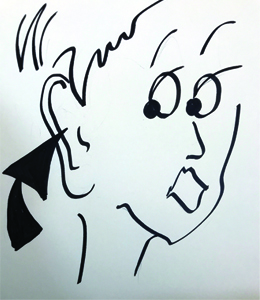 One of the most important skills a graphic recorder strives to develop is acute listening skills. This month I am examining listening biases. For those who remember the Simon and Garfunkel lyrics from “The Boxer” it says, “Still a man hears what he wants to hear and disregards the rest….” A more current reference from Madonna’s hit “Frozen” states, “You only see what your eyes want to see, you only hear what your ears want to hear…”
One of the most important skills a graphic recorder strives to develop is acute listening skills. This month I am examining listening biases. For those who remember the Simon and Garfunkel lyrics from “The Boxer” it says, “Still a man hears what he wants to hear and disregards the rest….” A more current reference from Madonna’s hit “Frozen” states, “You only see what your eyes want to see, you only hear what your ears want to hear…”
Think about these statements as it applies to the current political rhetoric. We may judge. We may have prejudice against them – a person or a defined group of people who are not us. Our judgments influence our listening, our attitudes and decisions, and our behavior. When we hear only what we want to hear, we misinterpret what the other person is really saying based on our own preconceived notions and don’t get a balanced perspective of an issue. Sometimes we’re aware of the biases we have, and sometimes they are unconscious biases. We are not born with any kind of bias. We learn and acquire bias; therefore, we can also unlearn bias.
It takes a self-awareness to recognize a bias and keep it in check to receive the clear and unfolding message during a meeting, training session or keynote. This is what I am focusing on this month with graphic recording. When listening to a variety of topics, how can I detect bias in my listening? How can you become aware of bias in your own listening? Different from the familiar gender, age or nationality types of bias, here are some other examples:
Peer Pressure Bias
Wanting to fit in to a desired group can encourage us to conform to opinions or points of view different from own thoughts of what is right or wrong. If ‘everyone thinks’ a certain way, what happens to us or our organizations if we don’t take the time to reflect and form our own opinions or are afraid to express them? What a loss of creative ideas! As a graphic recorder, I listen carefully to what I see and hear. Graphic recording displays all statements without hierarchy. In a room with multiple levels of people within an organization, the statements from a person higher up the ladder may hold more weight with the group than a statement coming from an individual contributor. Graphic recording takes away that bias, providing a more balanced picture of the opinions in a room.
Affinity Bias
When we hear someone’s message that immediately bridges to us personally because of a commonality, we may overemphasize that part of the message. I was mapping a Ted Talk about the Meaning of Technology. The speaker said he got rid of all his technology, including his car, and decided to ride his bicycle across the United States. I immediately keyed in on that and included it in my map. Was it a key element of his speech? Not really – it was an example – but I’m a cyclist who would love to ride my bicycle across the country. It is my bias and caught my attention.
Confirmation Bias
This occurs when we seek information that confirms our own pre-existing beliefs or assumptions. Maybe the speaker reminds us of someone else we know…someone who we disliked (or liked). Maybe this is a person with an accent that is difficult to understand, or someone whose rate of speech is way too fast. On the other hand, maybe the speaker is advocating for a cause in which we passionately believe. Early in my career I took a project management course with an instructor who had a heavy accent. I had so much trouble understand what he was saying, I just shut down and the course was a total waste of time for me. I was angry and frustrated. What happens when I do some graphic recording and the speaker takes me back to that spot? Shutting down is not an option. When preparing for a graphic recording project, I always hold a few meetings with the client. Preparation on the topic and listening to others with the same accent can prepare me to relax and be more confident. It will set the project up for success.
Listening and graphic recording in a neutral state, open-minded and without bias is important to be able to capture the facts and feelings of the audience and to tell/draw the story that is unfolding. I’m finding that focus on finding bias is important to reach the first step of awareness. Where are my biases? Where are yours? Search for them and think about how they impact what you do and the decisions you make.
We graphically illustrate complex concepts like finances, and capture multi-day strategy sessions to communicate the message simply and visually. Contact us if you’d like to see your message clearly!
